land warfare armored tactics pdf
Armored tactics are central to modern land warfare, emphasizing mobility, protection, and firepower. The evolution of armored vehicles has transformed battlefield strategies, enabling rapid deployments and enhanced combat effectiveness. From historical developments to contemporary conflicts, armored warfare continues to play a pivotal role in achieving strategic objectives, as seen in recent Russian-Ukrainian operations.
1.1 Definition and Scope of Armored Warfare
Armored warfare involves the use of armored fighting vehicles to achieve strategic and tactical objectives on the battlefield. It combines mobility, firepower, and protection to dominate land warfare scenarios. The scope extends from conventional battles to asymmetric conflicts, integrating advanced technologies like UAVs and precision munitions. Modern armored tactics emphasize adaptability, as seen in recent conflicts, where armored vehicles play a crucial role in both offensive and defensive operations, ensuring operational success across diverse terrains and combat environments.
1.2 Historical Evolution of Armored Tactics
The historical evolution of armored tactics began with World War I, where tanks were first introduced to break trench warfare stalemates. By World War II, armored warfare matured with the development of combined arms tactics and Blitzkrieg strategies. The interwar period saw advancements in tank design and doctrine, while modern conflicts have integrated advanced technologies like UAVs and precision-guided munitions, reshaping armored tactics to address contemporary threats and operational challenges.
1.3 Importance of Armored Vehicles in Modern Warfare
Armored vehicles are indispensable in modern warfare, providing unparalleled mobility, protection, and firepower. They enable forces to operate effectively in high-threat environments, safeguarding personnel while delivering decisive combat power. Advanced armor materials and integrated systems enhance survivability, while their presence on the battlefield fosters psychological deterrence. The versatility of armored vehicles across diverse terrains and scenarios underscores their critical role in achieving strategic objectives, as evidenced in contemporary conflicts like the Russian-Ukrainian war.
Historical Development of Armored Tactics
Armored tactics evolved significantly from early armored vehicles to modern advanced systems, shaped by wartime innovations and technological advancements, influencing contemporary military strategies and operations globally.
2.1 Early Use of Armor in Warfare
The use of armor in warfare dates back to ancient times, with early civilizations employing chariots and shield walls for protection. Armored vehicles like siege engines and battering rams were used to breach fortifications. The concept of armor evolved over centuries, with medieval knights utilizing steel plate armor for personal protection. These early forms of armor laid the groundwork for modern armored warfare, emphasizing protection and mobility on the battlefield.
2.2 World War I and the Birth of Tank Warfare
World War I marked the emergence of tank warfare, with the first operational use of tanks by the British in 1916 during the Battle of the Somme. Early tanks were slow, cumbersome, and prone to mechanical failures but provided crucial protection against machine-gun fire and artillery. Their introduction revolutionized land warfare by offering a means to break through entrenched positions and overcome the stalemate of trench warfare, paving the way for modern armored tactics.
2.3 Interwar Period and the Rise of Blitzkrieg Tactics
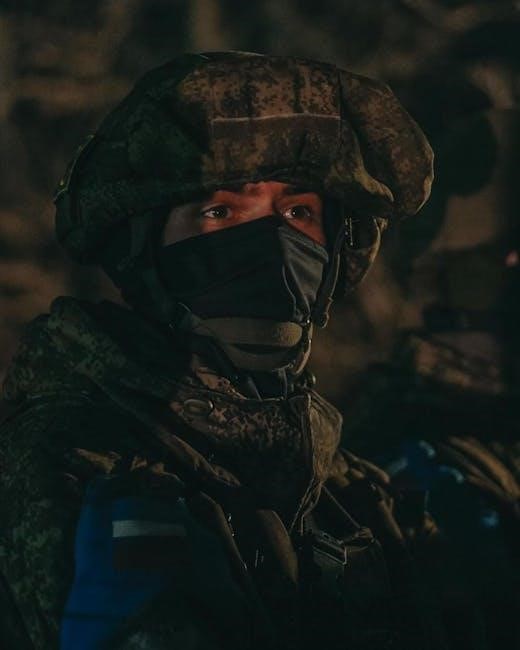
The interwar period saw the refinement of armored warfare, with Germany pioneering Blitzkrieg tactics. These tactics emphasized rapid, coordinated attacks combining armor, infantry, and air support to achieve swift breakthroughs. The development of faster, more reliable tanks and doctrines focusing on mobility and surprise transformed traditional battlefield strategies. Blitzkrieg was first tested during the Spanish Civil War and later perfected in World War II, revolutionizing land warfare with its emphasis on speed and decisive action.
2.4 World War II and the Maturation of Armored Warfare
World War II marked the maturation of armored warfare, with tanks becoming central to battlefield strategies. Advances in tank design, such as thicker armor and more powerful weaponry, enhanced their effectiveness. Tactics like combined arms operations and rapid armored thrusts were perfected by both Axis and Allied forces. Battles such as El Alamein and Kursk showcased the decisive role of armor in achieving strategic objectives, solidifying its importance in modern warfare.
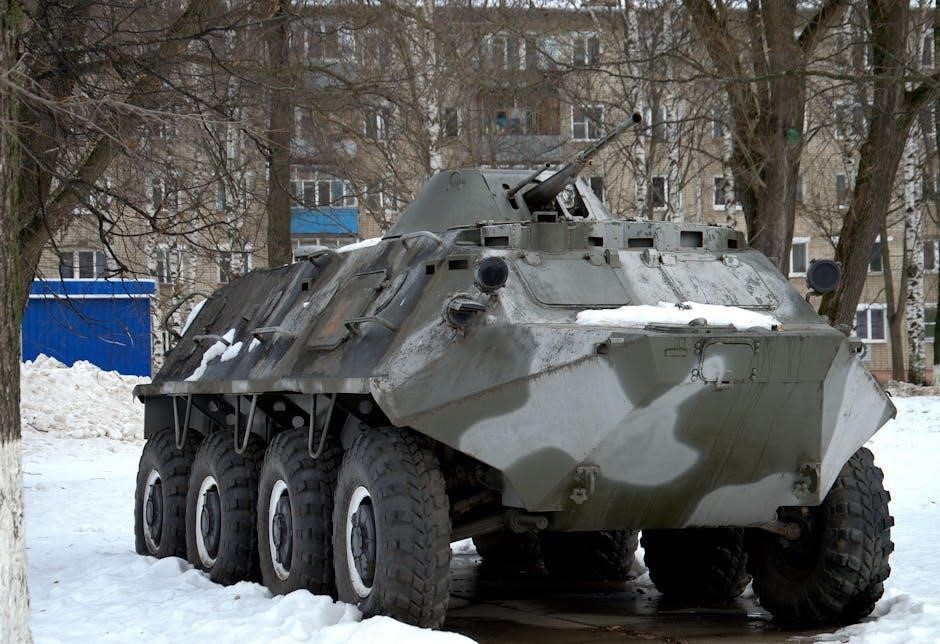
Core Principles of Armored Tactics
Armored tactics emphasize mobility, surprise, and firepower. They rely on coordinated operations between armor and infantry, ensuring rapid deployment and sustained combat effectiveness on the battlefield.
3.1 Mobility and Surprise in Armored Operations
Mobility and surprise are cornerstone principles of armored tactics, enabling forces to exploit weaknesses and catch adversaries off guard. Rapid deployment of armored units across vast terrains allows for decisive strikes, while surprise enhances the element of shock, disrupting enemy command structures. These tactics, as seen in modern conflicts like the Russian-Ukrainian war, demonstrate how armored forces can reshape battle dynamics through swift and unpredictable maneuvers, ensuring strategic superiority on the battlefield.
3.2 Firepower and Protection in Modern Tanks
Modern tanks combine exceptional firepower with advanced protection systems, making them formidable on the battlefield. Equipped with precision-guided munitions and state-of-the-art fire control systems, tanks deliver devastating firepower while maintaining high accuracy. Armor innovations, such as composite materials and active protection systems, enhance survivability against anti-tank threats. These advancements ensure tanks remain central to land warfare, providing both offensive and defensive capabilities that are critical in contemporary conflicts, as highlighted by their role in recent military operations.
3.3 Coordination Between Armor and Infantry
Effective coordination between armor and infantry is crucial for achieving tactical superiority. Armored vehicles provide cover and mobility, while infantry ensures close-quarters combat effectiveness. Modern tactics emphasize combined operations, where tanks suppress enemy positions and infantry secures terrain. Real-time communication and shared situational awareness enhance this synergy. Historical and contemporary conflicts, such as the Russian-Ukrainian war, highlight the importance of this coordination, ensuring seamless execution of battlefield strategies and maximizing combat efficiency in diverse operational environments.
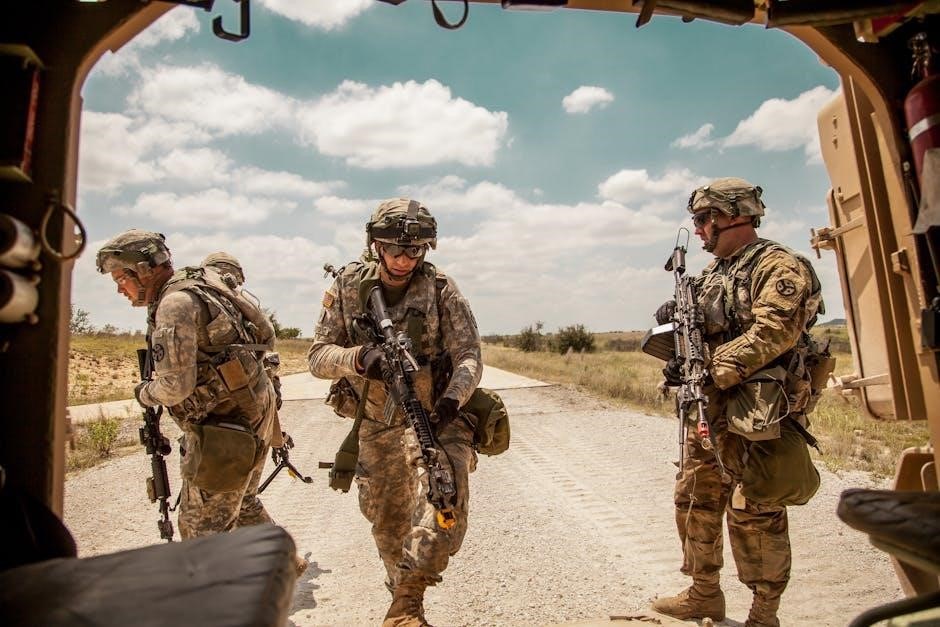
3.4 Logistics and Maintenance in Armored Units
Logistics and maintenance are critical to the operational readiness of armored units. Ensuring continuous supply chains for fuel, ammunition, and spare parts is essential for sustained operations. Advanced maintenance systems, such as those developed by Plasan and BAE Systems, enable rapid repair and upgrades. Modern conflicts highlight the importance of efficient logistics, as delays can compromise mission success. Effective maintenance strategies ensure armored vehicles remain combat-ready, addressing challenges like terrain constraints and supply chain disruptions in dynamic warfare environments.
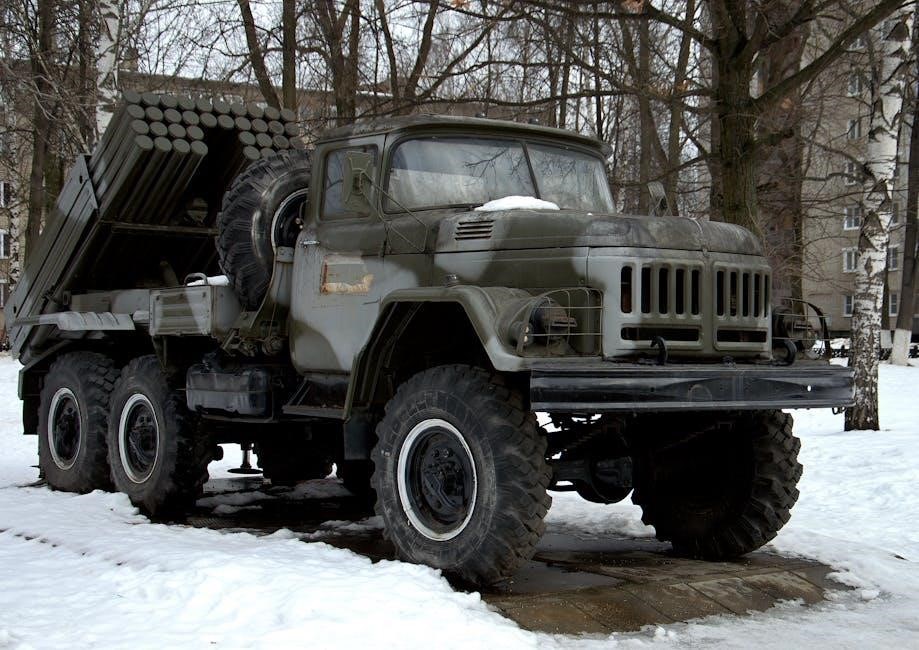
Technological Advancements in Armored Warfare
Technological advancements in armored warfare include advanced armor materials, integration of UAVs, precision-guided munitions, and network-centric warfare, enhancing combat effectiveness and real-time decision-making capabilities.
4.1 Development of Advanced Armor Materials
The development of advanced armor materials has significantly enhanced vehicle survivability. Modern solutions, such as composite armor and active protection systems, provide superior resistance to anti-tank missiles and IEDs. Companies like Plasan have pioneered lightweight, high-strength materials integrated into over 20,000 vehicles globally. These innovations ensure better protection while maintaining mobility, addressing evolving threats in contemporary conflicts, such as those seen in the Russian-Ukrainian war, where armored vehicles face sophisticated weaponry.
4.2 Integration of UAVs and Drones in Armored Tactics
The integration of UAVs and drones into armored tactics has revolutionized battlefield operations. These systems provide real-time intelligence, enhancing targeting accuracy and situational awareness. Drones enable armored units to detect threats like IEDs and enemy positions, reducing risks. In conflicts such as the Russian-Ukrainian war, Ukrainian forces have effectively used drones to destroy Russian assault troops, demonstrating their strategic value. This synergy between armored vehicles and aerial assets boosts operational efficiency and lethality in modern warfare.
4.3 Precision-Guided Munitions and Fire Control Systems
Precision-guided munitions and advanced fire control systems have significantly enhanced the accuracy and lethality of armored warfare. These systems enable tanks and armored vehicles to engage targets with pinpoint accuracy, minimizing collateral damage. Modern fire control systems integrate real-time data from various sources, improving decision-making and operational efficiency. In conflicts like the Russian-Ukrainian war, such technologies have proven critical in neutralizing high-value targets, demonstrating their strategic importance in contemporary armored tactics and network-centric warfare.
4.4 Network-Centric Warfare and Real-Time Data Sharing
Network-centric warfare has revolutionized armored tactics by enabling real-time data sharing across the battlefield. Advanced systems integrate sensors, UAVs, and drones to provide unparalleled situational awareness. This connectivity allows armored units to coordinate seamlessly, enhancing precision and operational efficiency. Real-time data sharing also facilitates faster decision-making, enabling forces to adapt swiftly to dynamic combat scenarios. Such technologies are critical in modern conflicts, as seen in the Russian-Ukrainian war, where data-driven strategies have become essential for gaining a strategic edge.
Strategic and Tactical Considerations
Strategic and tactical considerations in armored warfare involve adapting to urban environments, countering asymmetric threats, and balancing mobility with protection. Modern conflicts demand versatile and adaptive approaches.
5.1 Urban Warfare and Armored Vehicle Challenges
Urban warfare poses unique challenges for armored vehicles, including narrow streets, ambush risks, and limited maneuverability. The confined environment increases vulnerability to IEDs and anti-tank weapons. Armored vehicles must balance protection with agility, while coordinating closely with infantry to mitigate risks. Modern armor, like Plasan’s integrated systems, enhances survivability, but urban terrain remains a significant operational hurdle, requiring adaptive tactics to maintain effectiveness in densely populated areas.
5.2 Asymmetric Warfare and Counterinsurgency Tactics
Asymmetric warfare challenges armored forces with unconventional tactics, such as IEDs and ambushes. Insurgents often target armored vehicles using low-cost, high-impact weapons. Counterinsurgency requires armored units to adapt, emphasizing mobility and precision. Advanced armor systems, like those developed by Plasan, enhance survivability. Ukrainian forces have employed drones to counter Russian assaults, showcasing the evolving nature of asymmetric threats. Armored tactics must integrate intelligence and agility to neutralize such threats effectively in modern conflicts.
5.3 Psychological Impact of Armored Forces on the Battlefield
Armored forces exert significant psychological influence, intimidating enemies and bolstering friendly morale. The presence of advanced armored vehicles can instill fear, lowering enemy resolve. Conversely, armored support enhances troops’ confidence, providing a sense of security. Modern conflicts, like the Russian-Ukrainian war, highlight how armored tactics can demoralize opponents. The visual and auditory impact of armored units reinforces their strategic value, making them a powerful tool in shaping battlefield perceptions and outcomes.
5.4 Economic and Political Factors Influencing Armored Tactics
Economic and political factors significantly shape armored tactics, as nations invest heavily in armored vehicle technology to maintain strategic advantages. Companies like BAE Systems and Plasan drive innovation through R&D, while geopolitical tensions influence military spending. Political decisions often dictate the allocation of resources for armored units, impacting their deployment and effectiveness. Economic sanctions and access to advanced materials further complicate the development of armored warfare capabilities, as seen in the Russian-Ukrainian conflict, where economic constraints have influenced tactical choices.
Case Studies and Real-World Applications
Real-world applications of armored tactics are evident in conflicts like the Russian-Ukrainian war, where armored vehicles play a crucial role in modern warfare strategies and outcomes.
6.1 The Use of Armor in the Russian-Ukrainian Conflict
Armored vehicles have played a pivotal role in the Russian-Ukrainian conflict, with both sides employing advanced armor systems for mobility and protection. Russian forces have utilized armored columns in large-scale assaults, while Ukrainian forces have effectively targeted these formations using drones and anti-tank weapons. The conflict highlights the evolving nature of armored warfare, where adaptability and technological integration remain critical to operational success on the modern battlefield.
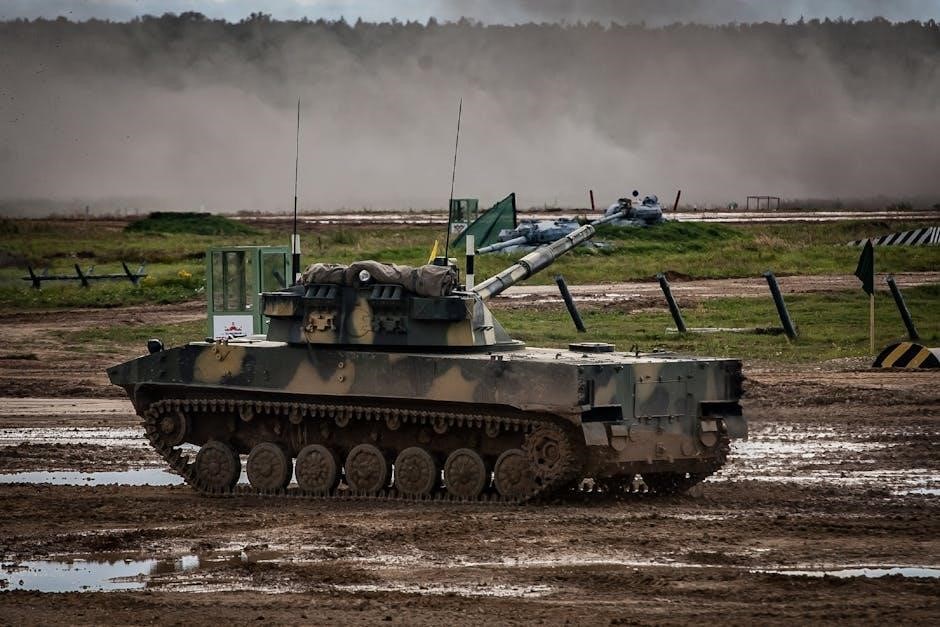
6.2 Armored Warfare in the Middle East Conflicts
Armored warfare in the Middle East has been shaped by urban combat and asymmetric threats. Countries like Israel, Iran, and Saudi Arabia have employed armored vehicles to counter insurgencies and protect against conventional threats. The use of UAVs and anti-tank missiles has become prevalent, while armored vehicles adapt to urban terrain challenges. These conflicts highlight the importance of mobility, precision, and resilience in modern armored tactics, reflecting broader global trends in land warfare strategies.
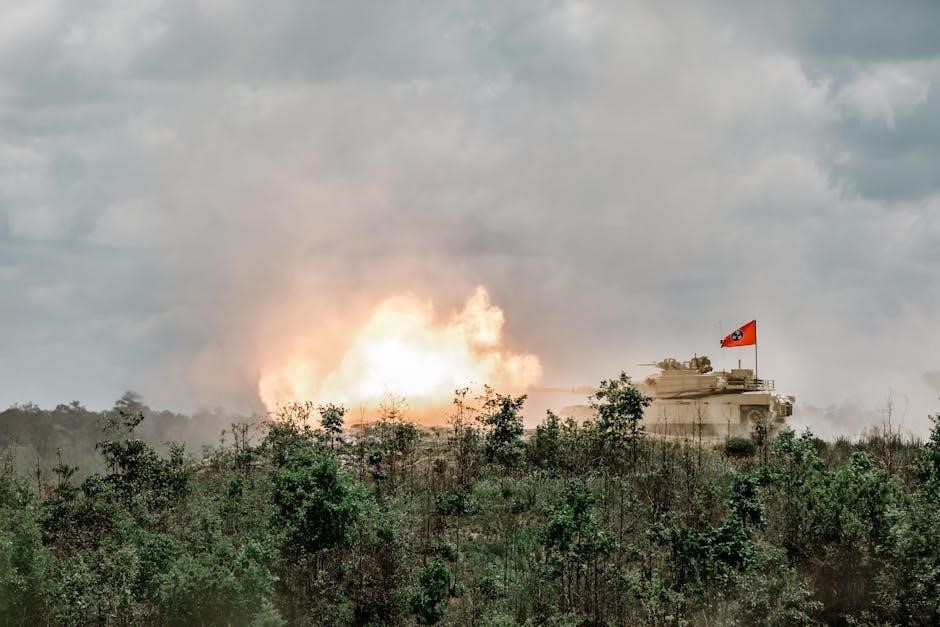
6.3 Historical Case Studies of Successful Armored Campaigns
Historical armored campaigns highlight the effectiveness of coordinated tactics and technological superiority. During World War II, the North African Campaign showcased the importance of mobility and logistics, while the European Theater demonstrated the power of combined arms operations. Successful campaigns often relied on rapid deployment, terrain adaptation, and strategic coordination between armor and infantry. These case studies provide valuable lessons in maximizing armored potential, emphasizing the balance between firepower, protection, and maneuverability on the battlefield.
6.4 Lessons Learned from Modern Armored Operations
Modern armored operations highlight the importance of adaptability and technological integration. The Russian-Ukrainian conflict underscores the role of UAVs and precision-guided munitions in enhancing battlefield awareness. Urban warfare challenges, such as in Middle Eastern conflicts, reveal vulnerabilities of armored vehicles to asymmetric threats. Effective coordination between armor and infantry remains critical, as seen in historical campaigns. Lessons emphasize the need for robust logistics, terrain adaptability, and network-centric warfare to optimize armored unit performance in dynamic combat environments.
Challenges and Limitations of Armored Warfare
Armored vehicles face vulnerabilities to advanced threats, environmental constraints, and logistical challenges. Maintenance demands and ethical concerns further complicate their deployment in modern conflict scenarios effectively.
7.1 Vulnerabilities of Armored Vehicles to Modern Threats
Modern armored vehicles face increasing vulnerabilities to advanced anti-tank missiles, improvised explosive devices (IEDs), and precision-guided munitions. These threats can bypass traditional armor, causing significant damage. Additionally, the proliferation of drones and UAVs has introduced new risks, as they can target armored units with unprecedented accuracy. Environmental factors, such as urban terrain, further exacerbate these vulnerabilities, limiting maneuverability and exposing vehicles to ambushes. These challenges underscore the need for continuous advancements in armor technology and tactical strategies to mitigate risks effectively in contemporary conflicts.
7.2 Environmental and Terrain Constraints on Armor
Armored vehicles face significant challenges in diverse environments and terrains. Urban warfare confines movement, with narrow streets and tall buildings creating ambush risks. Soft ground, such as mud or sand, can immobilize vehicles, while mountainous regions limit deployment and maneuverability. Forests and jungles obstruct visibility and restrict movement, complicating tactical operations. Extreme weather conditions, like heavy rain or snow, reduce traction and visibility, further hindering effectiveness. These environmental factors necessitate adaptive tactics and specialized equipment to maintain operational efficiency in varied combat zones.
7.3 Maintenance and Supply Chain Challenges
Maintenance and supply chain issues are critical in armored warfare. Armored vehicles require constant upkeep to ensure operational readiness, with complex systems needing specialized tools and expertise. Supply chains must deliver spare parts, fuel, and ammunition efficiently, often under fire. Disruptions can immobilize units, affecting mission success. The availability of skilled technicians and resources becomes a strategic challenge, especially in remote or hostile environments, where delays can compromise operational effectiveness and put troops at risk.
7.4 Ethical and Legal Considerations in Armored Warfare
Ethical and legal challenges in armored warfare include minimizing civilian casualties and adhering to international laws. The use of advanced weaponry raises moral dilemmas, as collateral damage can occur despite precision technologies. Legal frameworks, such as the Geneva Conventions, govern the conduct of armored operations, ensuring humane treatment of combatants and non-combatants. Ethical considerations also extend to the psychological impact of armored forces on civilians, emphasizing the need for transparency and accountability in military actions to maintain legitimacy and global trust.

The Future of Land Warfare Armored Tactics
Emerging technologies like AI, autonomous vehicles, and advanced materials are reshaping armored warfare, enhancing efficiency and lethality while addressing modern threats and operational challenges.
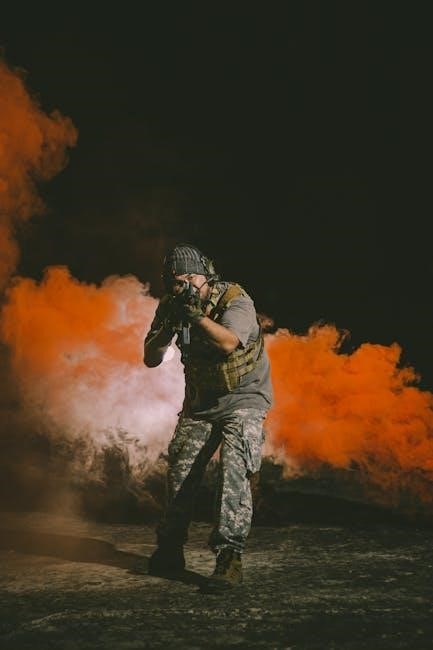
8.1 Emerging Technologies and Their Impact on Armor
Emerging technologies are revolutionizing armored warfare, with advancements in materials science, AI, and autonomous systems. Companies like BAE Systems and Plasan are developing lightweight, adaptive armor, while UAVs enhance reconnaissance and targeting. AI-driven systems improve decision-making and survivability, enabling real-time threat detection. Autonomous vehicles and network-centric warfare further transform tactics, allowing seamless coordination and data sharing. These innovations ensure armored forces remain effective against evolving threats, blending lethality with precision and adaptability.

8.2 The Role of AI and Autonomous Vehicles in Future Warfare
AI and autonomous vehicles are reshaping future warfare by enhancing decision-making and operational efficiency. AI enables real-time data processing, predictive maintenance, and adaptive tactics, while autonomous vehicles reduce human risk in logistics and surveillance. These technologies integrate seamlessly with network-centric warfare, allowing for faster, more precise operations. Autonomous systems are expected to complement manned armor, optimizing resource allocation and enhancing survivability on the battlefield.
8.3 Evolving Tactics to Counter Advanced Threats
Modern armored tactics are adapting to counter advanced threats like anti-tank missiles and drones. Strategies include active protection systems, electronic warfare, and real-time data sharing. The integration of UAVs for reconnaissance and precision-guided munitions enhances targeting accuracy. These evolving tactics focus on increasing survivability and operational effectiveness against sophisticated adversaries, ensuring armored forces remain decisive on the battlefield.
8.4 Global Trends in Armored Vehicle Development
Global trends in armored vehicle development focus on advanced materials, modularity, and network-centric capabilities. Lightweight composites and active protection systems enhance survivability. Integration of AI, autonomous systems, and UAVs improves battlefield awareness. Modern designs emphasize versatility, allowing rapid reconfiguration for diverse missions. These innovations ensure armored vehicles remain effective against emerging threats, adapting to the dynamic nature of modern warfare while maintaining operational superiority on the battlefield.
Conclusion
In conclusion, armored tactics remain a cornerstone of modern land warfare, shaped by historical evolution, technological advancements, and strategic adaptability. The integration of advanced materials, AI, and network-centric systems underscores the future trajectory of armored warfare. Despite challenges like urban terrain and asymmetric threats, armored vehicles continue to offer unparalleled mobility and firepower. As global conflicts evolve, the development and deployment of cutting-edge armored systems will remain critical to achieving military objectives and ensuring operational success on the battlefield.









Leave a Comment